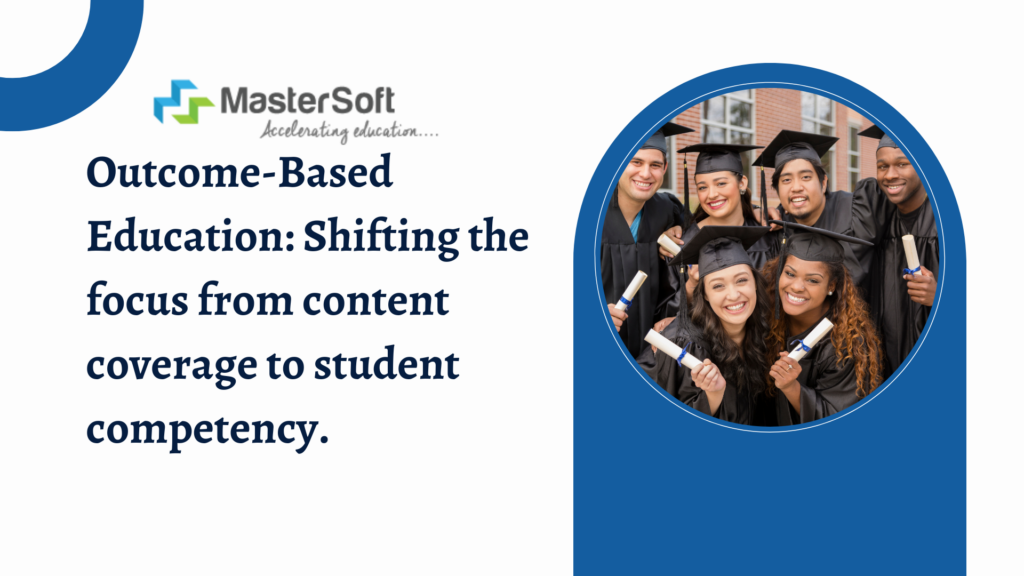Transforming Learning with Outcome-Based Education: A Comprehensive Guide

The Rise of Outcome-Based Education
In today’s rapidly evolving educational landscape, traditional teaching methods are being re-evaluated to better meet the needs of students and society. This rethinking has given rise to Outcome-Based Education (OBE), a transformative approach focused on what learners can actually do after they are taught. Understanding “Outcome-Based Education” is crucial for educators and institutions striving to enhance learning efficacy and relevance.
What is Outcome-Based Education?
Defining the Concept
Outcome-Based Education (OBE) is a student-centered learning model that prioritizes the desired outcomes of the educational process. Unlike traditional education, which often emphasizes the content delivered or time spent in the classroom, OBE focuses on what students should be able to demonstrate upon completing a course or program. These outcomes are specific, measurable skills and knowledge that reflect real-world applications and competencies.
Key Characteristics
-
Clear Objectives: OBE begins with defining explicit, measurable learning outcomes. These objectives guide the curriculum, teaching methods, and assessments.
-
Student-Centered: The focus is on what students achieve rather than what instructors teach. Learning experiences are designed to help students meet these outcomes effectively.
-
Flexibility in Teaching: Instructors can adapt their methods and pace according to student needs, as long as the defined outcomes are achieved.
-
Continuous Improvement: OBE involves regular assessment and feedback to ensure that educational practices lead to the desired student outcomes, allowing for ongoing refinement of the teaching process.
Historical Context and Evolution of OBE
Origins and Early Adoption
Outcome-Based Education emerged in the late 20th century as a response to perceived shortcomings in traditional educational models. Educational theorist William Spady is often credited with popularizing OBE, emphasizing the need for a clear focus on outcomes rather than inputs in education. Early adopters of OBE were often motivated by a desire to improve student preparedness for the workforce and ensure that graduates possessed the necessary skills and competencies.
Adoption and Adaptation Worldwide
Over the years, OBE has been implemented in various forms across the globe, particularly in higher education and vocational training. Different countries and institutions have adapted OBE principles to align with their specific educational goals and contexts, resulting in a diverse array of applications and interpretations of the model.
Modern Developments
Recent advancements in educational technology and data analytics have further refined OBE practices. Digital tools enable more precise tracking of student progress and outcomes, while online learning platforms offer new opportunities for personalized, outcome-focused education.
Designing Curriculum with OBE Principles
From Objectives to Outcomes
The foundation of an OBE curriculum lies in clearly defined learning outcomes. These outcomes articulate what students are expected to know, be able to do, or value by the end of a course or program. Designing an OBE curriculum involves several key steps:
-
Identify Desired Outcomes: Begin by determining the specific skills, knowledge, and attitudes that students should acquire. These outcomes should be aligned with industry standards, societal needs, or professional competencies.
-
Develop Learning Activities: Create activities that support the achievement of the desired outcomes. These activities should be varied and engaging, accommodating different learning styles and providing opportunities for practical application.
-
Align Assessments: Design assessments that accurately measure the attainment of the outcomes. These assessments should be performance-based, allowing students to demonstrate their competencies in real-world contexts.
Incorporating Flexibility
One of the strengths of OBE is its adaptability. Instructors can tailor their teaching strategies and materials to best meet the needs of their students, as long as the learning outcomes are met. This flexibility encourages innovative teaching practices and fosters a more personalized learning experience.
Implementing OBE in the Classroom
Active Learning Techniques
Implementing Outcome-Based Education in the classroom requires active learning techniques that engage students and promote deep understanding. These techniques align with the principles of OBE by focusing on the application of knowledge and skills.
Effective Strategies
-
Problem-Based Learning: Introduce real-world problems that require students to apply their knowledge and skills to find solutions. This approach encourages critical thinking and practical application.
-
Collaborative Projects: Facilitate group work where students collaborate on projects or assignments. This not only helps in achieving outcomes related to teamwork and communication but also enhances learning through peer interaction.
-
Reflective Practices: Encourage students to reflect on their learning process and outcomes. Reflection activities, such as journals or portfolios, help students internalize their learning experiences and identify areas for improvement.
Technology Integration
Technology can enhance the implementation of OBE by providing diverse tools for learning and assessment. Online platforms, simulations, and digital assessments can offer interactive and adaptive learning experiences that align with outcome-based objectives.
Assessing Student Outcomes
Aligning Assessment with Outcomes
In OBE, assessment plays a crucial role in measuring the extent to which students have achieved the defined outcomes. Effective assessment practices are aligned with the learning outcomes and provide meaningful feedback to both students and educators.
Types of Assessments
-
Formative Assessments: These assessments occur throughout the learning process and provide ongoing feedback. Examples include quizzes, class discussions, and peer reviews. Formative assessments help identify areas where students may need additional support or practice.
-
Summative Assessments: Conducted at the end of a learning unit or course, summative assessments measure the cumulative achievement of learning outcomes. Examples include final exams, capstone projects, or presentations.
-
Performance-Based Assessments: These assessments require students to demonstrate their skills and knowledge in practical, real-world contexts. Examples include portfolios, practical exams, or case studies.
Feedback Mechanisms
Providing timely and constructive feedback is essential in OBE. Feedback should focus on how well students have achieved the outcomes and offer guidance on how to improve. Effective feedback mechanisms include rubrics, one-on-one conferences, and self-assessment tools.
Benefits of Outcome-Based Education
Enhancing Student Learning
One of the primary benefits of Outcome-Based Education is its positive impact on student learning. By focusing on specific outcomes, OBE provides a clear direction for both teaching and learning, helping students understand what is expected of them and how to achieve it.
Key Advantages
-
Clarity and Focus: OBE provides clear, measurable objectives, helping students understand their learning goals and how to achieve them. This clarity fosters motivation and engagement.
-
Real-World Relevance: OBE aligns learning outcomes with real-world applications, ensuring that students acquire skills and knowledge that are directly applicable to their future careers or personal endeavors.
-
Personalized Learning: The flexibility of OBE allows for personalized learning experiences that cater to individual student needs, preferences, and learning styles.
-
Improved Accountability: OBE promotes accountability for both students and educators. Students are responsible for achieving the outcomes, while educators are accountable for providing the necessary support and guidance.
Institutional Benefits
For educational institutions, OBE can lead to improved program quality, better alignment with industry standards, and enhanced student satisfaction. By focusing on outcomes, institutions can demonstrate the effectiveness of their programs and attract students who value practical, competency-based education.
Challenges and Solutions in Implementing OBE
Addressing Common Challenges
Despite its benefits, implementing Outcome-Based Education can present challenges. Common issues include resistance to change, difficulties in defining measurable outcomes, and the need for continuous assessment and feedback.
Effective Solutions
-
Change Management: Implementing OBE often requires a shift in mindset and practice. Institutions can facilitate this change by providing professional development opportunities, fostering a culture of collaboration, and involving all stakeholders in the process.
-
Outcome Definition: Defining clear, measurable outcomes can be challenging. Institutions should involve subject matter experts, industry partners, and educators in the process to ensure that outcomes are relevant and achievable.
-
Assessment Strategies: Developing effective assessment strategies requires careful planning and alignment with outcomes. Institutions can support this process by providing resources and training for educators on designing and implementing performance-based assessments.
-
Feedback Systems: Establishing robust feedback systems is essential for continuous improvement. Institutions should create mechanisms for collecting and analyzing feedback from students, educators, and external stakeholders.
The Future of Outcome-Based Education
Emerging Trends and Innovations
As education continues to evolve, Outcome-Based Education is likely to adapt and incorporate new trends and innovations. The integration of technology, data analytics, and personalized learning will play a significant role in the future of OBE.
Potential Developments
-
Digital Learning Platforms: The rise of digital learning platforms offers new opportunities for delivering outcome-based education. These platforms can provide personalized learning paths, adaptive assessments, and real-time feedback, enhancing the OBE experience.
-
Data-Driven Decision Making: Advances in data analytics can help institutions better understand student performance and learning outcomes. By analyzing data on student progress, institutions can identify trends, predict challenges, and implement targeted interventions.
-
Lifelong Learning: OBE’s focus on competencies and real-world skills makes it well-suited for lifelong learning. As the demand for continuous education grows, OBE principles can support individuals in acquiring new skills and knowledge throughout their lives.
Sustaining the Impact
To sustain the impact of OBE, institutions must remain committed to continuous improvement and innovation. This involves regularly reviewing and updating learning outcomes, incorporating feedback from stakeholders, and exploring new ways to enhance teaching and learning practices.
Conclusion: Embracing Outcome-Based Education
Outcome-Based Education represents a significant shift in how we approach teaching and learning. By focusing on measurable outcomes, OBE aligns educational practices with the needs of students and society, ensuring that learners acquire the skills and knowledge necessary for success in a rapidly changing world. Embracing OBE requires commitment and adaptability,

 How to Find the Best Tutor in Los Angeles?
How to Find the Best Tutor in Los Angeles?  How You Get into the Canada’s Largest Engineering School
How You Get into the Canada’s Largest Engineering School  Explore the Top 10 Reasons Why to Study in the abroad!
Explore the Top 10 Reasons Why to Study in the abroad!  The Best Time to Book a Short Stay Apartment in Dubai
The Best Time to Book a Short Stay Apartment in Dubai  Maximize Your Potential With A CDL Truck Driving School
Maximize Your Potential With A CDL Truck Driving School  How students can book accommodation in York House Nottingham?
How students can book accommodation in York House Nottingham?  Exploring London’s Best Butcher Shops
Exploring London’s Best Butcher Shops  Enhance Your Shop Appeal with Sydney’s Best Carpentry Services
Enhance Your Shop Appeal with Sydney’s Best Carpentry Services  A Detailed Look at the Features of the LEGO Technic Mars Crew Exploration Rover
A Detailed Look at the Features of the LEGO Technic Mars Crew Exploration Rover